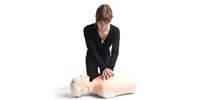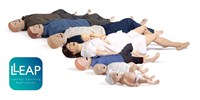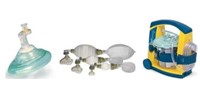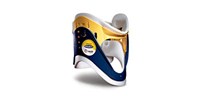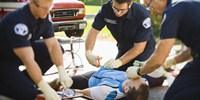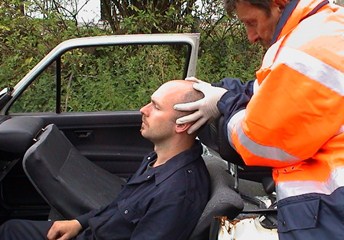Issues in Spinal Care
Spinal cord injuries (SCI) are one of the most tragic consequences of trauma due to the tremendous lifestyle changes and financial impacts incurred.
These types of injuries affect more than 13000 Americans every single year and many more Worldwide. There are millions of incidents such as traffic collisions (48%) , falls ( 21%), violent acts (14%) and sports injuries (14%) , each with the potential for causing a spine or cord injury. The number presents actual cord injuries. Millions more are potential cord injury patients. Spine injury is a situation EMS providers will face on a daily basis. 1 3 5
The economic impact is substantial. It costs over $1,250,000 to care for the victim of a permanent cord injury. Both the economic and human aspects of spinal cord injury should be prime concerns for EMS providers. 1 3 5
SCI presents a variety of treatment challenges for EMS personnel. Approximately 40% of trauma patients with neurological deficits have significant and sometimes permanent spinal cord damage. Up to 25% of this damage occurs during the pre-hospital and emergency department phases of treatment, some of this may be due to improper handling and transportation techniques.2
The spine is intended to provide skeletal support as well as protection for the spinal cord. The vertebra have to main parts: the body and the arch.3
The majority of injuries to the spine result from trauma or excessive movement of the spine in different directions e.g. flexion, extension, rotation, lateral bending, compression and distraction. Forces being used causing trauma or excess motion can lead to injuries like: vertebral fracture, dislocation, subluxation, cord contusion and vascular damage
The main goal of the emergency care provider is to prevent additional cord damage, which may result in further deterioration of the spinal cord. Both cost and damages can be reduced by having obvious and defined treatment goals along with greater focus and more training on these types of injuries.
Treatment goals:
Treatment by pre-hospital and in-hospital personnel is directed towards stabilization of existing injuries, prevention of secondary cord injury and safe transportation to an appropriate facility.
This is accomplished by restraining the spine in the neutral position. By restricting movement, the internal area of the canal and the diameter of the cord remain constant, reducing the chance for secondary injury or neurological/vascular compromise from additional compression forces.
EMS providers are taught to initiate complete spinal motion restriction procedures not only when an obvious neurological deficit exists, but whenever the possibility of a spinal injury exists. To help determine if a spine or cord injury may exist, evaluate the mechanism of injury and the sign and symptoms associated with spinal trauma.
The signs and symptoms – presence of any one of the following indicators necessitates spinal motion restriction: 4
Unconsciousness or Altered Level of Consciousness (ALOC) in a suspected trauma patient
- Presence of neurological deficits:
Paralysis
Weakness
Paresthesia
Priapism - Head, neck or back pain associated with trauma
- Obvious head or neck trauma
- Signs of shock without etiology
In-hospital providers work toward the same goal by continuing the motion restriction established in the pre-hospital setting, initiating care on patients who have by-passed the pre-hospital care system.
Considerations when using a rigid collar/extrication collar:
It has been stated numerous times in the literature that rigid collars provide more effective immobilization of a patient’s cervical spine than soft or semi-rigid collars. 6 With the improvements in immobilization offered by using rigid collars, however, goes the responsibility of the rescuer to properly use of such devices. As a brief review on the critical nature of accurate sizing, proper application and final adjustments of e.g. Stifneck®, for safe, effective immobilization, please consider the following comments:
1) Sizing: When immobilizing a patient with a rigid collar, it’s critical for the rescuer
to select the proper size. Too tall a collar can hyper-extend a patient’s cervical spine, force the jaw closed and limit access to the airway. Too short a collar can lead to inadequate immobilization, which may enable a patient to slip their chin
off the chin piece and inside the collar into a hyperflexed position. If applied tightly, too short a collar may act as a constructive band and impede venous blood
flow, thereby leading to increased intracranial pressure. Tight application of too short a collar may also limit access to the trach hole for carotid pulse monitoring.
The key dimension on a patient is the distance between an imaginary line drawn across the top of the shoulders, where the collar sit, and the bottom of the patient’s chin. The key dimension on the collar is the distance between the sizing post and the lower edge of the rigid plastic-encircling band. When the patient is being held in neutral position, use your fingers to visually measure the distance from the shoulder to the chin.
Keep in mind that sizing must be carried out when the patient is in neutral position. If a patient is supine without the head being supported in a neutral position, the chin may tilt back, causing the rescuer to select a taller collar than necessary.
2) Application:
Once the proper size has been selected, it should be recognized that for optimal patient care, the patient’s chin must be well supported by the chin piece. One of the most simple maneuvers, yet critical to collar placement, involves bending or flattening of the chin piece as the collar is moved up the chest wall. These are easiest done by putting your thumbs in both corners of the tracheal hole and then press the chin piece down. Folding the chin piece down helps to reduce any premature contact with the mandible.
Important note: Many providers attempt to position the collar by pushing it in towards the neck. Often, the collar contacts the mandible prematurely causing improper placement or selection of a shorter sized collar. Bending the chin piece down will eliminate both of these problems.
Another re-occurring problem is the failure to tighten the collar adequately. If the collar is too loose, the chin piece will move forward decreasing the support of the mandible.
3) Final adjustments:
As a final check on how well the collar has been sized and applied, the rescuer should once again make sure that the patient looks to be in neutral position and that the collar has been tightly enough so that there is no chance that the patient’s chin will slip off inside the chin piece. Ideally, the end of the chin should be flush with the front edge of the chin piece, but in all cases the patient’s chin should at least cover the plastic rivet located in the middle of the chin piece.
Spinal motion restriction must incorporate a system approach. Necessary components of motion restriction include a rigid spine board, a rigid cervical collar, and a cervical resistant device to anchor the head to the spine board and equipment for securing the body to the spine board. Do not use a cervical collar alone as adequate motion restriction. 4
System solution: Laerdal provides a full system solution with:
- The Stifneck® or Stifneck® Select
- BaXstrap Spineboard
- Headbed II Cervical Immobilisation Device (CID)
- PadPack Alignment pads
- High quality straps
References:
1) National Academy Press. Injury in America. A continuing Public Health Problem, 1985
2)Toscano, J. Prevention of Neurological Deteroration Before Admission to a Spinal Cord Injury Unit. Paraplegia, 1988
3) University of Alabama, Birmingham. Spinal Cord Facts and Figures, 1986
4) Campbell JE, Editor, Chapter 7: Spinal Cord Trauma. Basic Trauma Life Support: Basic Prehospital Trauma Care Guidelines, 1988
5) Rue DP, MacKenzie EJ, and Associates. Cost of Injury in the United States: A report to Congress, 1989. Institute for Health and Aging, University of California and Injury Prevention Center, The Johns Hopkins University
6) McCabe JB, Nolan DJ: A compariosn of the effectiveness of different immobilization collars. Ann Emerg. Med 1986
7) Podolsky S, Baraff LJ, Simon RR, Hoffman JR, Larmon B, Ablon W. Efficacy of Cervical Spine Immobilization Methods. J of Trauma, 1983;23

